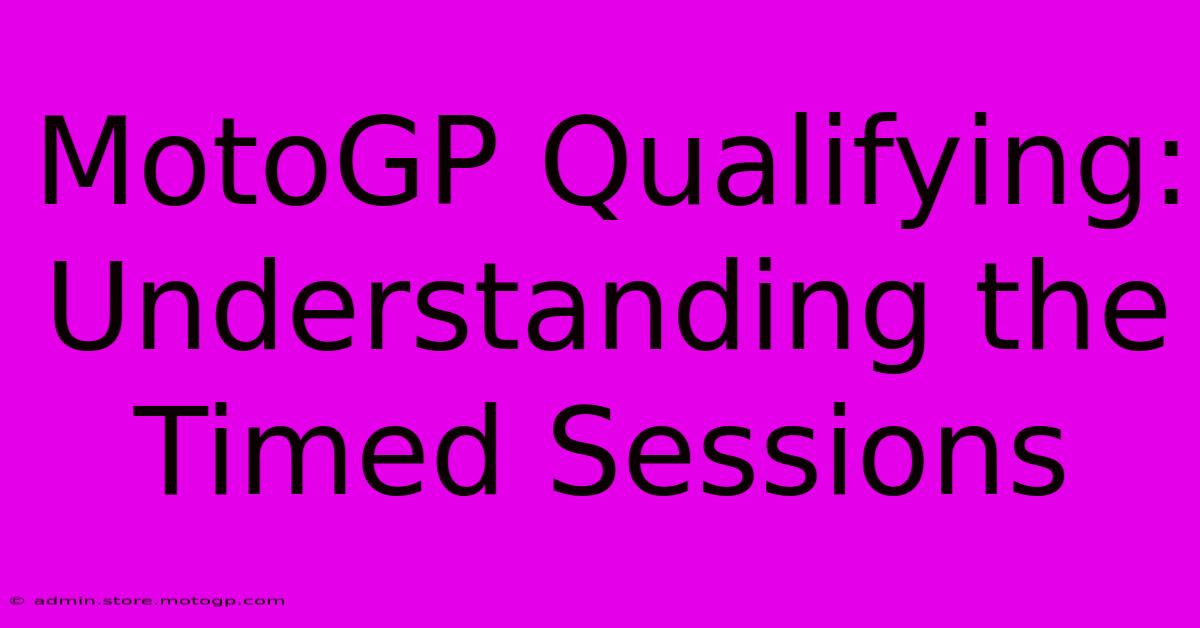MotoGP Qualifying: Understanding The Timed Sessions

Table of Contents
MotoGP Qualifying: Understanding the Timed Sessions
MotoGP, the pinnacle of motorcycle racing, is a spectacle of speed, skill, and strategy. But before the lights go out on race day, the riders engage in a crucial battle against the clock: qualifying. Understanding the qualifying sessions is key to appreciating the drama and intricacies of a Grand Prix weekend. This guide breaks down the MotoGP qualifying process, explaining the formats and the importance of each session.
The Qualifying Format: A Step-by-Step Guide
The qualifying format in MotoGP has evolved over the years, but the current system aims to deliver exciting sessions and a fair representation of rider pace. Here's a breakdown:
FP1 & FP2 (Free Practice Sessions):
These two free practice sessions, typically held on Friday and Saturday morning, are crucial for setting the stage. Teams gather data on bike setup, tire performance, and track conditions. While not directly contributing to qualifying positions, these sessions are invaluable for determining the optimal strategies for the crucial qualifying sessions. Riders use this time to try different settings, experiment with tire compounds, and improve their lap times.
FP3 (Free Practice 3):
This Saturday morning session is particularly important. The combined times from FP1, FP2, and FP3 determine which riders automatically progress directly to Q2. Typically, the top 10 riders from this combined time sheet advance.
Q1 (Qualifying 1):
Riders who didn't make the top 10 in the combined free practice sessions participate in Q1. This 15-minute session is intense, with riders pushing their limits to secure one of the top two positions. Only the two fastest riders from Q1 graduate to Q2. This creates a high-pressure environment, with riders fighting for their place in the main qualifying shootout.
Q2 (Qualifying 2):
Q2 brings together the top 10 riders from FP3 and the two fastest from Q1. This 15-minute session determines the starting grid positions for the race. The rider with the fastest lap time earns pole position, with subsequent positions determined by their respective lap times. This session is often characterized by dramatic overtaking maneuvers and intense battles for the coveted pole position.
The Importance of Qualifying in MotoGP
Qualifying isn't just about securing a good starting position; it has significant implications for the race itself:
-
Track Position: A strong starting position is crucial in MotoGP, as overtaking can be challenging, particularly at some circuits. Starting from the front row dramatically increases the chance of securing a podium finish.
-
Race Strategy: A rider's qualifying performance can influence their race strategy. A front-row start allows for a more aggressive, race-leading strategy, while a lower grid position may necessitate a more conservative approach.
-
Tire Management: The tires used during qualifying can affect the tire choice for the race, impacting the rider's strategy for tire wear and performance.
-
Psychological Advantage: Securing pole position provides a psychological boost for the rider and the team, enhancing confidence going into the race.
Understanding the Factors Affecting Qualifying Performance
Numerous factors contribute to a rider's qualifying performance:
-
Rider Skill: The rider's skill, experience, and ability to push their limits under pressure are paramount.
-
Bike Setup: The motorcycle's setup, including suspension, aerodynamics, and engine mapping, must be optimized for qualifying pace.
-
Tire Choice: Selecting the appropriate tire compounds for the qualifying session is critical.
-
Track Conditions: Changes in track temperature, grip levels, and weather conditions can significantly affect qualifying times.
-
Team Strategy: The team's strategy for tire usage and race setup significantly impacts the performance during qualifying.
Conclusion: The Qualifying Showdown
MotoGP qualifying is a captivating display of skill, precision, and intense competition. Understanding the format, the importance of the sessions, and the factors that influence performance enhances the viewing experience and allows for a deeper appreciation of the strategic nuances of this thrilling motorsport. The battle for pole position is often just as exciting as the race itself, shaping the narrative and setting the stage for Sunday's grand prix.

Thank you for visiting our website wich cover about MotoGP Qualifying: Understanding The Timed Sessions. We hope the information provided has been useful to you. Feel free to contact us if you have any questions or need further assistance. See you next time and dont miss to bookmark.
Featured Posts
-
Cota Track Days Experience The Difference
Feb 18, 2025
-
Beyond Pole The Untold Story Of The F1 Starting Grid
Feb 18, 2025
-
Moto Gp 23 Ps 5 The Ultimate Racing Simulator Experience
Feb 18, 2025
-
The Science Behind Motorbike Racing Performance
Feb 18, 2025
-
Experience The Ride The Comfort Of A Moto Gp Helmet
Feb 18, 2025
